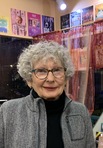Judith Works's Blog, page 8
August 28, 2014
SITKA: Kale Smoothies and Cathedral Bells

Sitka is a small town with a big history. There has been human activity for the last 10,000 years when it was settled by the Tlingit people, but is best known to American history students as the capital of Russian America. The Russians arrived in 1799, naming their fur trading outpost Fort Saint Michael. The Tlingit managed to throw them out in 1802, but not for long. Alexander Baranof, the Russian governor, won the Battle of Sitka in 1804 and renamed his nascent town New Archangel. In 1804 it was named capital of Russian America, which comprised all of Alaska and a fort near Bodega Bay (Fort Ross) and plantations south of the Russian River in California. When the Russians were forced to sell off Alaska in 1867 due to financial woes, Sitka was the site of the signing of the Alaska Purchase.
While my husband went in search of sea otters and other wildlife, I spent day in search of memories of Russia. I did not have to look far. The National Park Service maintains the Russian Bishop’s House, completed in 1843 as an ecclesiastical palace, New World style. It includes the first bishop's personal residence and chapel along with a seminary and native school.

A portrait of the czar presided over Bishop Innocent and his samovar when he entertained dignitaries:
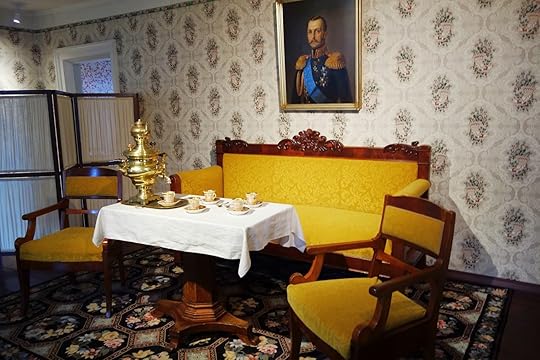

Russia’s interest in the coastal areas of Alaska was mainly limited to the trade in sea otter pelts, the most valuable of all furs. When the population of otters was close to extinction, the Russians drifted home. A leftover pelt was draped over a bench in the Bishop’s house. The Park Service tour guide asked if I wanted to try it on. Of course! The fur was soft and dense, and very heavy. It wasn’t hard to imagine Russian aristocracy wearing their sables and otter furs as their horses dashed through the snowy countryside.
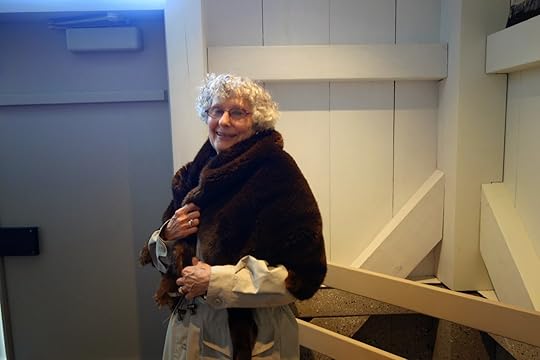
Not all Russians made it home alive. The dark and overgrown cemetery is a melancholy reminder that life in the vast wilderness territory was tenuous. Some of the headstones are made of ship's ballast.

The lovely Russian Orthodox church is in the center of town:

Built in 1848, the cathedral was nearly destroyed by a fire in 1966. The priceless icons, enormous chandelier and other church furnishings were saved, and the church was rebuilt to the same plans.

A Native American priest welcomed me. I told him I was waiting for a friend who is the bell ringer. Near noon, she and I climbed the 58 steep steps to the top of the bell tower where all Sitka listened to her short concert played on eight bells.


You can watch and hear the music recorded on what looks like a cold and wintery day when she hosted a group of visitors.https://www.youtube.com/watch?v=MSAU5fgQx-Q&feature=youtu.be

My stereotyped view of the locals was upended when I had a quick lunch at the Homeport Eatery which provides coffee, baked goods, a pub, creperie and organic wine bar for citizens and tourists. A rough and ready type wearing rain gear and rubber boots bellied up to the bar to order a kale smoothie and a veggie crepe. Apparently real men are different in Alaska.

The last part of my tour was several of the many art galleries in the small town. My favorite was the Rose Gallery next to the Bishop’s House. It is filled with exquisite local art and walrus tusk ivory carvings by natives who live on islands in the Bering Sea. I purchased several fine woodcuts by Eric Bealer who lives in a tiny village on Chichagof Island, north of Baranof Island where Sitka is located.

Sitka has an annual music and arts festival running in the summer. We are already making plans to return to see more wildlife, sample native jazz and other enticing offerings.

All photos copyright Judith Works, except that of the Russian cemetery taken from photos on Bing.
Published on August 28, 2014 13:52
August 1, 2014
THE COLORS OF ALASKA
After watching gigantic cruise ships sail past our home on Puget Sound every summer for years we finally decided to try an Alaska cruise ourselves. But we didn't want to be with three or four thousand people on a fast round trip from and back to Seattle. On the other end of the scale are expedition ships that focus on a specific area and we wanted an overview. We settled on the Navigator owned by Regent Seven Seas Cruises and which operates on one-week cruises from Vancouver BC to Anchorage or the reverse. It holds 490 passengers, maximum, and was a good choice for us.
Next problem was worries about the weather. Southeast Alaska is notorious for rain at any time of the year and we were sailing in June, hardly the height of their brief summer. I expected gray, maybe more than fifty shades, but we were fortunate and found the long days drenched in color. Sky, water, mountains, flowers, native art and even signage combined to make a kaleidoscope of beauty.
The cool color of ice of Hubbard Glacier where our captain sprinkled ashes on the water in honor of a local deity. We assumed the ashes were from one of the many volcanoes - or did the chef burn something? At any rate, it worked because the weather held.

And icebergs in Tracy Arm:

The many colors of Russian dolls in Sitka:
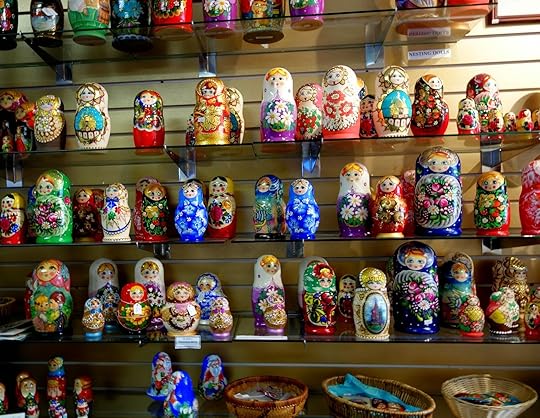
And Russian icons in the Orthodox St. Michael's Cathedral:
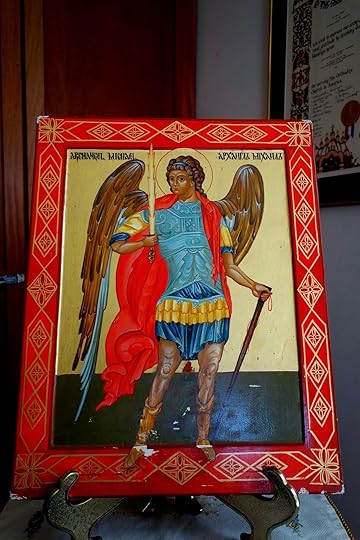
And malachite green, too:
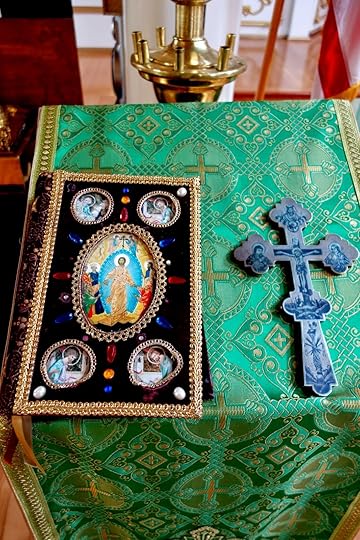
The brilliant color of a coffee ad in Skagway:
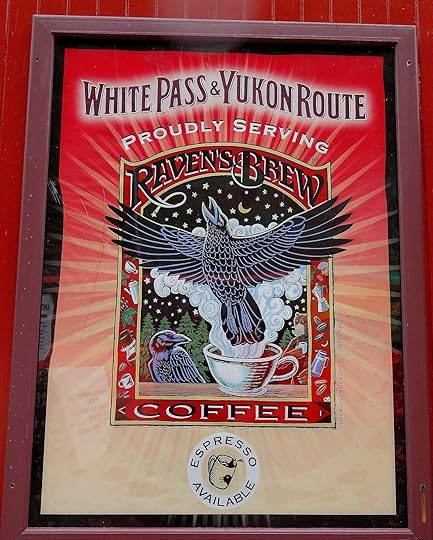
The pink of wild roses:

And of foxgloves:

The orange of salmonberry:

The multicolored flower baskets everywhere:

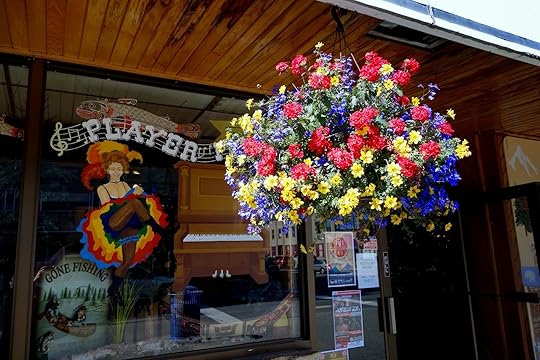
The soft colors of Tlingit art on weathered gray cedar:


And the brightness of new masks in a museum in Ketchikan:

Even the no smoking signs get the message across with color:

We saw pods of orcas; schools of whales; and herds of sea lions, along with sea otters, bear and innumerable birds. Too difficult to photograph well, they made for an unforgettable experience, especially when we saw two eagles leap into the air from an iceberg as it turned upside down while a Humpback whale breached. A truly spectacular memory of Alaska.
Next problem was worries about the weather. Southeast Alaska is notorious for rain at any time of the year and we were sailing in June, hardly the height of their brief summer. I expected gray, maybe more than fifty shades, but we were fortunate and found the long days drenched in color. Sky, water, mountains, flowers, native art and even signage combined to make a kaleidoscope of beauty.
The cool color of ice of Hubbard Glacier where our captain sprinkled ashes on the water in honor of a local deity. We assumed the ashes were from one of the many volcanoes - or did the chef burn something? At any rate, it worked because the weather held.

And icebergs in Tracy Arm:

The many colors of Russian dolls in Sitka:

And Russian icons in the Orthodox St. Michael's Cathedral:

And malachite green, too:

The brilliant color of a coffee ad in Skagway:

The pink of wild roses:

And of foxgloves:

The orange of salmonberry:

The multicolored flower baskets everywhere:


The soft colors of Tlingit art on weathered gray cedar:


And the brightness of new masks in a museum in Ketchikan:

Even the no smoking signs get the message across with color:

We saw pods of orcas; schools of whales; and herds of sea lions, along with sea otters, bear and innumerable birds. Too difficult to photograph well, they made for an unforgettable experience, especially when we saw two eagles leap into the air from an iceberg as it turned upside down while a Humpback whale breached. A truly spectacular memory of Alaska.
Published on August 01, 2014 16:12
June 27, 2014
ROMAN REMAINS

When in Rome it is always fascinating to follow the lives of ancient Romans. We read and see so much of corporate grandeur that it is easy to forget that individual Romans were real people with families. Families who had a preference for staying together in life as well as in death. When the inevitable happened the remains were often kept in mausoleums so the living could gather in memory of the deceased.
The best preserved of these memorials is the Vatican Scavi underneath St. Peters, where the wealthy went to their eternal rest. But if you want to wander in the sun among the middle class and common people’s tombs, a visit to the Necropoli di Porto is a place to spend some time. That is, if you can find it and get reservations. The Necropolis is located between the airport at Fiumicino and the mouth of the Tiber River on Isola Sacra and is not well signed. The famous ruins of Ostia Antica are a few miles away. (The whole ancient port area is now part of an enormous archaeological project called the Portus Project. The website is www.portusproject.org if you are interested in knowing more.)

The necropolis, a true city of the dead, is across a canal begun by Emperor Trajan for a direct connection between the meandering Tiber and the sea. After the fall of the Empire the area was gradually abandoned as it silted up and became a malarial swamp. It was reclaimed in 1920 and much of the land was turned into market gardens.

We began our tour at the ruins of the Basilica of Sant’Ippolito, constructed in the 4th Century over an earlier complex of baths, only uncovered in the 1970s. The church continued as a place of worship through the 13th Century. The Romanesque bell tower was converted to a watch tower by Pope Gregory XIII in 1585. The church houses some of the artifacts discovered at the site.
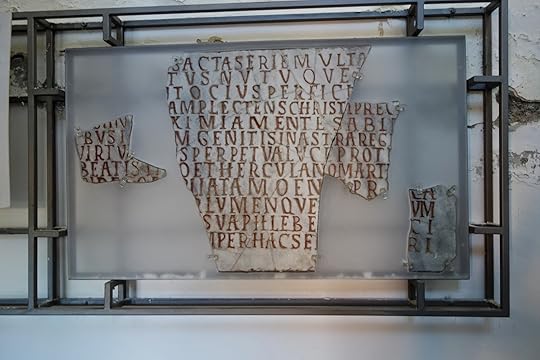
It is a short walk from the church to the necropolis where the remains of merchants, artisans and ship owners from Trajan’s port were to enjoy their sleep. The area is now protected by a chain-link fence and an on-site custodian but no actual remains are left, all lost long ago to the depredations of animals, antiquities hunters and archaeologists. Because the cemetery is so obscure not only are there no actual dead occupants, there were only a few other live ones wandering around when we visited.

The chamber tombs are rectangular, similar to little houses with door, thresholds, windows and terraces with couches for funeral feasts. Many face a cobbled road known as the Via Severiana that ran down the coast, now much farther away than in ancient times.

Outside some of the buildings are amphorae used to pour libations into the tomb.

The occupation of the deceased was often memorialized by a sculptured plaque showing activities such as those of a grain merchant or ship owner. One tomb has a mosaic of an African elephant, probably a strange sight to a member of the family visiting Africa.



Another tomb has a mosaic of the lighthouse and two ships, no doubt a welcome sight after a perilous sea voyage.
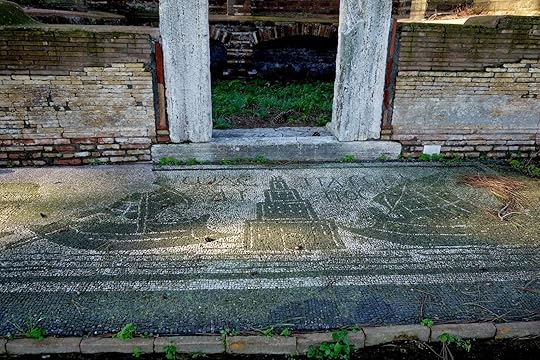
But the poorer could not afford such fancy memorials. They are buried in the ground under what looks like dog houses or little old-fashioned traveling trunks. Others only have simple tiles forming a peaked roof.

It’s hard to imagine what the lives of these humble souls lives could have been like – sailors stranded far from home, dock workers or laborers, all long forgotten except for the occasional wanderer, like us, who briefly wonders who they were.

If you want to visit you can check out www.archeoroma.beniculturali.it. I would suggest actually calling them.
Published on June 27, 2014 13:23
May 30, 2014
SPRING IN ZHUJIAJIAO
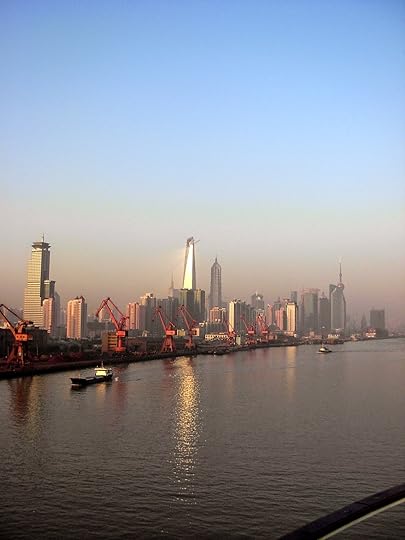
Shanghai can get pretty frantic with all the skyscrapers and crowds. If you are in need of a quick change of pace, a good choice is the quiet “water town” of Zhujiajiao, about an hour from the city by bus.
The area around Zhujiajiao was settled thousands of years ago, and the town itself has been around for about 1700 years, new in Chinese terms. Formerly a trading center for cloth and rice, it is now a getaway for tourists and locals who come to enjoy the peaceful watery setting.
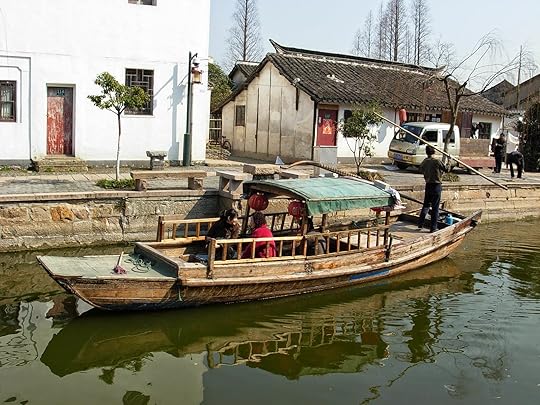
When we last visited, it was so early in the spring that the bare branches of the canal-side trees were decorated with laundry instead of leaves. I especially liked the blue briefs that brightened up a view of pale sky, green water, white houses and red lanterns hung outside doorways.
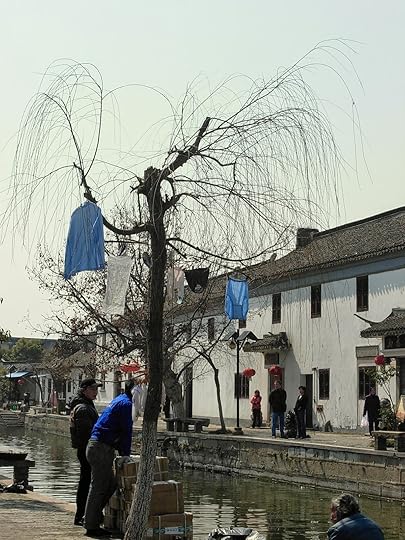
The sun was still weak and the locals were well bundled up as they played cards beside the canals or waited for shoppers.


We began with the obligatory boat ride on the placid waters, boarding near the Fangshen Bridge, built in 1571 and restored in 1812.

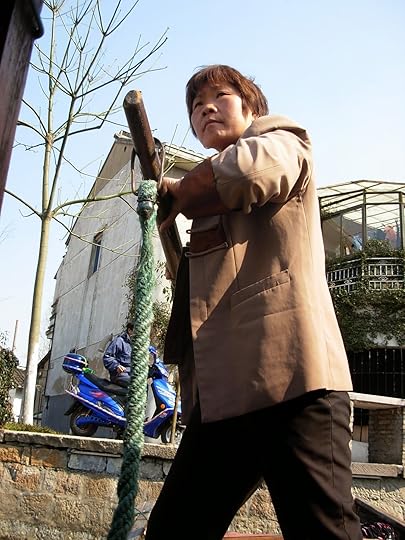
We glided under a number of the 36 smaller spans as a sturdy woman propelled the the boat with a wooden pole.
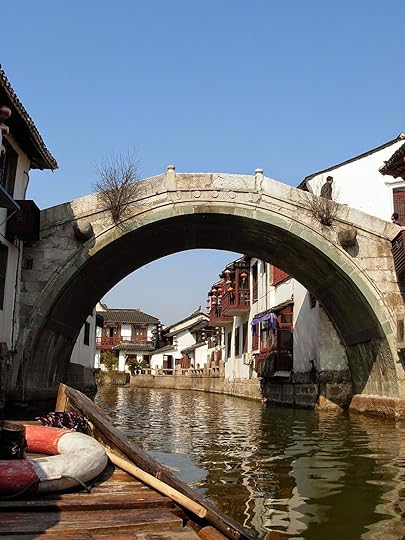
The voyage came to an end when we disembarked near the town’s center for a stroll through the Kezhi Garden with its contorted rocks and old buildings now housing new craftsmen demonstrating traditional Chinese arts such as paper cutting, calligraphy and embroidery.
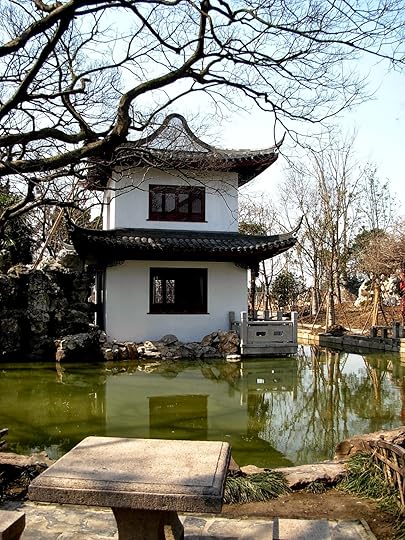
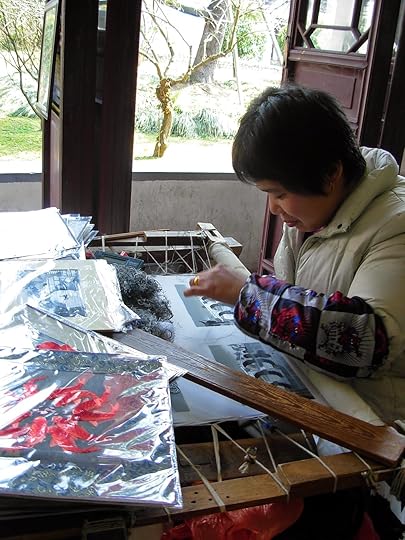
Later, we moved on to the main shopping area filled with tiny shops and a museum with displays about local culture including a kitchen and dining room from an upper-class family and wind-powered rice milling equipment. But lunch time was nearing and pots bubbling away presented some interesting choices.
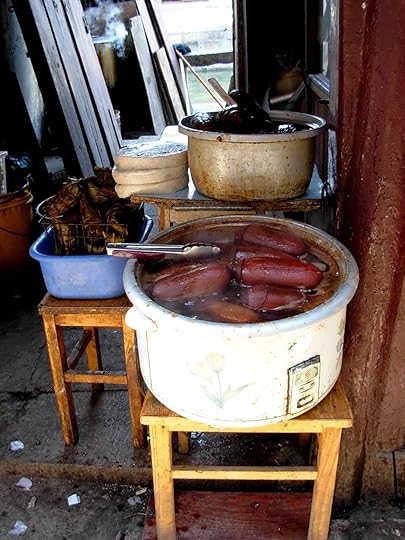
Instead of dining canal-side, we decided on a restaurant for an opportunity to sit down and get warm. On the way we saw this plump-cheeked child:
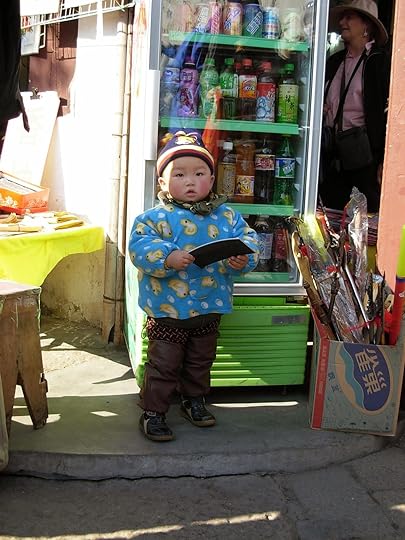
Outside the old post office we came to a wonderful mailbox. It says “Letters” in Chinese and English. The box is supported by a writhing dragon with five claws on each leg. The Imperial dragon represents a long-gone phase of Chinese history but despite the current lack of Emperor or Empress to oversee the mail system, the lock on the box looks new. I thought about posting a card to friends saying “I’ll be here for a while.”

All photos property of author
Published on May 30, 2014 09:42
May 4, 2014
A DAY WITH EMPEROR HADRIAN
Rome is so filled with treasures that it is often hard to know where to start. Sometimes it is easier to concentrate on one artist like Caravaggio or architect such as Bernini (who is almost impossible to avoid anyway). The last time we were in the city we decided to give one day to a Roman emperor, Hadrian, who ruled from AD 117 until his death in AD 138.

One of the few emperors who still gets good press as an administrator, he was a great traveler and builder, particularly in Rome. We began with one of the greatest architectural triumphs of all time, the Pantheon. Despite the inscription over the portico saying that it was built by Agrippa, Hadrian oversaw its reconstruction after it was twice nearly totally destroyed by fire.

The concrete dome at 142 feet across is larger than the dome at St. Peters and still the largest ever built of that material. The only light comes from the oculus, a hole in the center of the dome 30 feet in diameter. We stood to one side watching the sunlight slowly make its way across the floor, illuminating clumps of visitors. What would Agrippa, who originally built the temple to commemorate his victory over Antony and Cleopatra, think of all the tourists now enjoying the sight with no interest in the gods he worshipped?

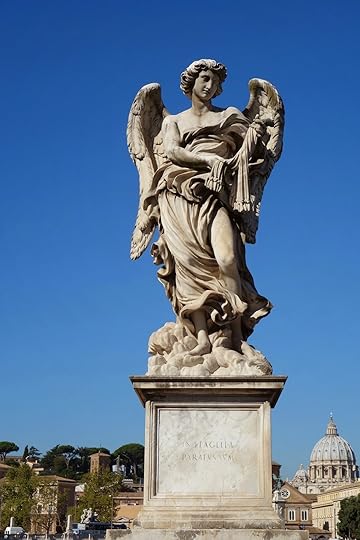
When it was time to move on, we turned in the direction of the Vatican, crossing the beautiful Ponte Sant’Angelo, lined with ten Bernini-designed statues.

The bridge was originally built in the second century AD by Hadrian as an impressive approach to his family mausoleum, now Castle Sant'Angelo. On this sunny day it was lined with fake artists selling prints as originals, and real artists industriously sketching or painting. I think Hadrian would be pleased with the admiration.

The tomb retains its basic round shape despite the centuries of rebuilding. Originally it was surrounded by cypress trees and topped by a bronze 4-horse chariot, driven by Hadrian personifying the sun. The statue was replaced in Christian times by an angel in thanks for relief from a plague. The interior has Renaissance-era canons and cannonballs but is now devoted to art exhibitions rather than defense.

We had lunch on the terrace overlooking St. Peter’s and Rome; instead of thinking about Cleopatra and her lovers we thought about the passageway that leads from the Vatican to the Castle used by Pope Clement VII to escape marauders in 1527. The pope probably ate better food but our view unforgettable, as only Rome can offer. It was time to leave the heat and crowds for the countryside. Villa Adriana, Hadrian’s country retreat, near the little town of Tivoli in the hills east of Rome was the largest estate in the Roman Empire. Now it is a fascinating collection of ruins comprising the remains of at least thirty residences, baths, theaters, libraries, and stadiums. The park-like setting with olive, cypress and umbrella pine trees is the perfect place to wander on a summer afternoon.

Hadrian began building in AD 118, the year after he became emperor and, amazingly, it was completed in ten years. The architectural styles are a glorious collection of travel souvenirs of his thirty years of travels throughout the empire.
I noticed the modern address of the complex is Largo Marguerite Yourcenar 1, an odd address until I remembered Marguerite Yourcenar is the author of the unforgettable Memoirs of Hadrian, a fictional autobiography "written" by Hadrian dedicated to his grandson, Marcus Aurelius. In further memory of her genius, the small museum at the site was hosting an exhibition dedicated to her life and work. It was appropriately titled “Imagined Antiquity.”
One aspect of Hadrian’s life has caught the attention of a number of authors: his passion for all things Greek, including the youth named Antinous. Within days of the discovery of his body in the murky floodwaters of the Nile where he and Hadrian had been hunting, the emperor founded a cult to immortalize him. The city, Antinopolis, built where the body was discovered, is now just a footnote in detailed guides to Egypt, but many museums including the Vatican have portraits of him as a god or otherwise idealized. His fleshy body, full lips and lush locks are instantly recognizable. Hadrian’s obsession is the subject of another fascinating book, Royston Lambert’s, Beloved and God.


The Canopus, an area with a reflecting pool bordered by statues, is thought to be the emperor’s memorial to Antinous, and to me is the more evocative area of the complex. I could visualize Hadrian in deep mourning walking beside the waters to put the cares of running the empire aside to dream of what might have been. We should all be so loved!

Photos by Judith Works except for the two statues and the painting which are from Wikipedia Commons.
Painting of the Pantheon is by Giovanni Paolo Panini, 1691-1765
Published on May 04, 2014 13:50
April 23, 2014
THE SACRED ISLAND OF MIYAJIMA

The ferry that leaves from a little port thirty minutes north of Hiroshima, Japan transports passengers to another dimension where the city’s memorials to the holocaust caused by the Atomic Bomb are left behind in spirit if not in physical distance. A first glimpse of what awaited us on Miyajima Island came in the form of origami paper cranes, symbolizing peace and memorializing the end of World War II. They were gracefully given out by smiling and bowing students at the ferry dock. We accepted the gifts with what was no doubt an ungraceful bow as we embarked on the short ride to a place where there are no births or deaths, no felling of trees, and tame deer – messengers from the gods – wander at will.

This vision of Shangri-La is home to the Itsukushima Shrine, dedicated to the three daughters of the god of sea and storms. Founded in AD 593, the current buildings date from the 16th century based on a 12th century design. The shrine’s most famous landmark, the great torii gate, appeared to float upon the hazy Inland Sea, a fitting mystical marker where the divine begins and mundane daily life ends.

My husband and I disembarked for a leisurely stroll to the shrine, ready to dissolve ourselves in the aura of peace and harmony the buildings generate despite the presence of other visitors sharing the experience. We walked along the waterside on a path lined with stone lanterns representing 108 earthly cares, passed through a granite torii gate firmly rooted to the land, rinsed our hands at the stone trough and entered an alternative universe. The brilliant vermillion lacquer of the buildings and passageways, matching that of the floating gate, was reflected in the blue sea. A sense of serenity enveloped us.

In one pavilion a white-robed priest was conducting a ceremony while an elderly couple kneeled on a tatami mat. We wondered if the ritual was to memorialize an ancestor, Shinto shrines often being used for that purpose rather than Buddhist temples. Shinto is Japan’s oldest religion, in existence since time immemorial. Deities, called kami, preside over all the things, living, dead or inanimate. Their shrines, large and small, dot Japan.

As the tide slowly ebbed, the shrine’s feet were no longer in the water and the earthly concern of time passing returned. With never enough of it to experience everything, we reluctantly left the sacred precinct to see the ornate 9th Century Daisho-in Buddhist Temple set in a wooded area beyond the shrine before admiring the Goju-no-to five-story pagoda built in 1407. It is enticingly set in the modern village filled with shops, inns and restaurants a contrast to the otherworldly feelings generated by the temple.
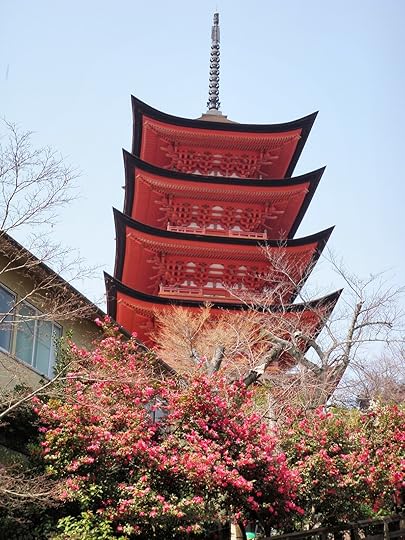
We wandered along the narrow street to look at souvenirs like the typical remembrance Japanese visitors purchase – rice scoops of all sizes. Of course, Hello Kitty in every guise was waiting too. Better was the chance to sample the island’s specialty food, momiji,bite-sized cakes in the shape of a maple leaf and flavored with various unexpected ingredients such as eel. But the most attractive of delights tempting us were the tiny stalls selling grilled oysters fresh from the surrounding sea. Delicious!

For those lucky to have time enough to stay on the island, there are backpacker hostels and hotels including romantic and expensive ryokan. The prospect of staying to walk the trails or meditate by a stone lantern in a soft rain overlooking a mist-soaked sea made us add a return to the island to our never-fulfilled list of places we wanted experience for the first, second, or third time.

An overnight stay was not to be this trip. Body and soul temporarily nourished, we returned to the ferry landing to await the next boat back to reality. Two young women looked up from their bento box afternoon snack to smile and make the typical Japanese peace sign. The deer wandered over, not delivering messages from the gods, but to munch on any paper they could find including ferry tickets for the unwary (maybe used to take messages from us back to the gods).

A sleepy child accompanied us back to Hiroshima and reality.

All photos property of Judith WorksAn earlier version of this story appeared in Travel Belles, www.travelbelles.com, http://www.travelbelles.com/2013/05/j...
Published on April 23, 2014 14:28
April 2, 2014
EARLY SPRING IN THE SKAGIT VALLEY: DAFFODILS AND QUILTS
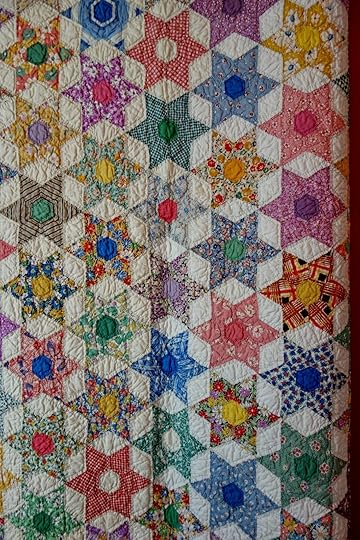
After what seemed like 40 days of rain the sun came out, warm and spring-like. It was the signal to take a drive an hour north of home to the small town of La Conner, located where the Skagit Valley meets saltwater in the form of the Swinomish Channel. The town was founded in 1867 and many of the original buildings remain. But instead of housing banks, churches, and butchers, they are clothing stores, art galleries, antique shops and restaurants. The town was also formerly the home of a large flock of wild turkeys but we didn’t see any this time. Word has it that they were sent to a rest home after causing a ruckus for too many years but disappointing the many birdwatchers who come to the area.
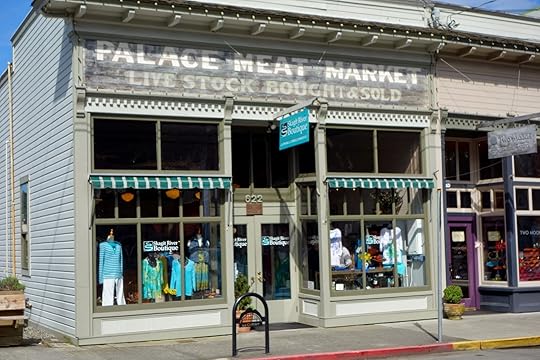
The nearby farmland is famous for bulb production along with other crops. The waterfront is lined with working craft to bring salmon, crab, mussels and oysters to the table.

Completing the picturesque scene is a red bridge which would not look out of place in Japan. It leads to the Swinomish Indian Reservation.

The annual Skagit Valley Tulip Festival was beginning without the cooperation of the tulips, but the enormous fields of daffodils were a delight.
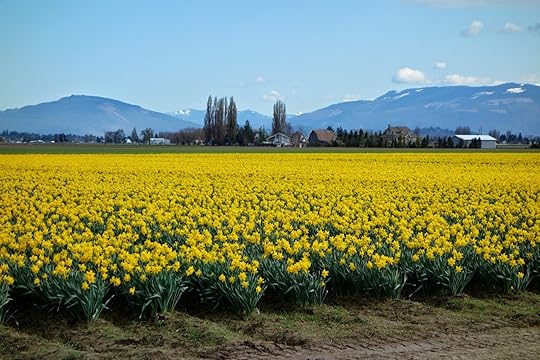
Old farmhouses, some of which have been turned into B&Bs, stood in the fields framed by the snowy Cascade Mountains and the hills of the San Juan Islands. In a week or so, the whole valley will be a blaze of color as the tulips reach their peak.

Our mission was specific: to visit the La Conner Quilt & Textile Museum (www.laconnerquilts.org) to donate a quilt made in the 1930s. The timing was fortuitous - the Winter exhibit of crazy quilts had been put away the day before and a new exhibit of quilts from the ’30s had just been arranged for Spring.
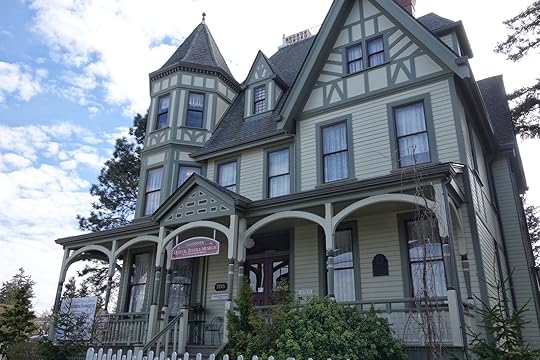
The museum is housed in the three-story Gaches Mansion dating to 1891, recently restored. After the curator looked at the quilt she showed us around and told us about the quilts displayed on walls along with an exhibit of suzanis donated by a local collector.
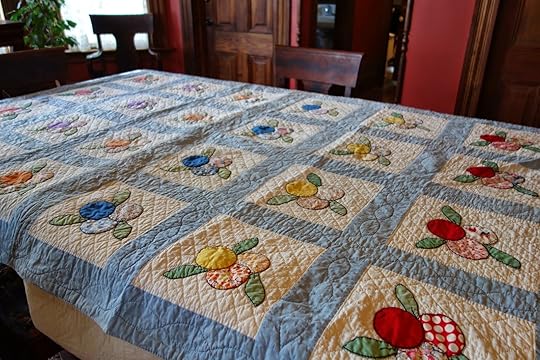
The curator decided to use our quilt as a table decoration for the three-month long Spring exhibit, so now it has joined many others made by farm women gathered together around a quilting frame to gossip and stitch fabric scraps from feed and flour sacks during the dark days of the Depression.

When it was lunch time, we chose the Nell Thorn Restaurant and Pub to sit by the water watching sailboats head out for an afternoon’s pleasure and an eagle circling lazily overhead. Across the channel, are three structures in the shape of Swinomish Indian hats used to welcome the paddlers of more than a hundred canoes from coastal tribes who gather every July to rest, share songs and tales of their journey across the sometimes treacherous waters.
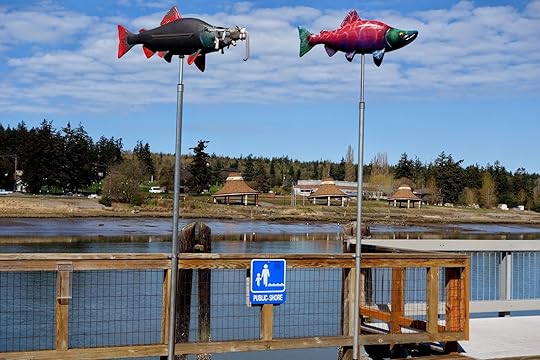
In keeping with the theme of "eat local," we dined on wonderful tiny oysters and local draft beer. Deciding to feed our minds after our stomachs were satisfied, we headed for the Museum of Northwest Art (www.museumofnwart.org) to see works by Mark Tobey, Kenneth Callahan and Guy Anderson. A special showing of John Cole’s work took up much of the ground floor. Some of his work, particularly the figures of women, reminded us of Gauguin although the landscape paintings are on Northwest themes.

Later, we passed flocks of laggard Snow Geese who winter by the hundreds of thousands in the area. It was time for them to go north to their nesting grounds and for us to go south to our home, grateful a prized member of the family has joined its sister quilts to be enjoyed by other admirers.


photos by author.
Published on April 02, 2014 10:31
March 5, 2014
THE CYCLE OF TIME - Tuscania

My friend and I drove to Tuscania through the countryside full of empty carved rock tombs, some so eroded that the steps leading to them now only reach empty sky – the heavens where perhaps Etruscan souls reside. But as we neared the town we could see that some of the tombs alongside the road were still in use, the hollowed area blocked off with doors hiding small cars or vats of wine.
The small city, in business since about the 8th century BC was founded by the Etruscans is interesting with its medieval and Renaissance buildings, although our visit would be focused on two churches now located about a mile from the walled old city. In the Etruscan era an earlier version of these walls enclosed a much larger city extending to include the site where the most distant church now stands. Over the centuries sieges and the Black Death so reduced the population that the city shrunk to a shadow of its former importance.
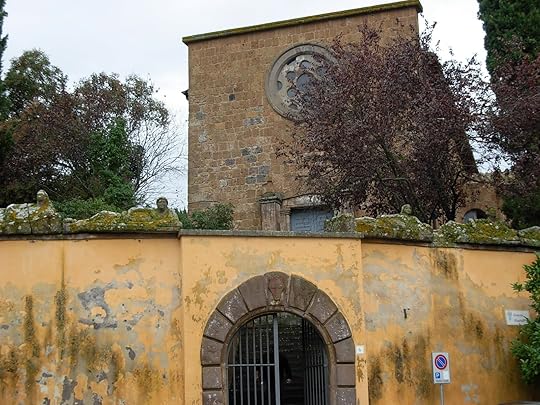 In present times, instead of defending against marauders, portions of the "new" city wall support stone sarcophagi, their lids carved with the likeness of the deceased. Some visages are still so crisp they appear as though they were chiseled the previous day. Others look melted as if time unhurriedly softened them. There are so many sarcophagi that the city may once have been a center for the coffin industry, all ready to go except for the heads which you or your descendants could have made in your likeness.
In present times, instead of defending against marauders, portions of the "new" city wall support stone sarcophagi, their lids carved with the likeness of the deceased. Some visages are still so crisp they appear as though they were chiseled the previous day. Others look melted as if time unhurriedly softened them. There are so many sarcophagi that the city may once have been a center for the coffin industry, all ready to go except for the heads which you or your descendants could have made in your likeness.Santa Maria Maggiore, the church at the bottom of the former Etruscan acropolis, was constructed over a Roman temple, a typical practice. Academics argue dates because it’s such a disorderly and asymmetrical composite of styles, materials and décor. Here a Pisan or Luccan touch, there Umbrian, or an idea borrowed from churches in the mountains of the Abruzzi. Some see elements from the Auvergne in France or those that could be Norman-Sicilian in derivation. The Romanesque style leads experts to guess that the church and its bell tower were created between 1000 and 1200 with pieces taken from other churches and temples, perhaps after earthquakes destroyed them.

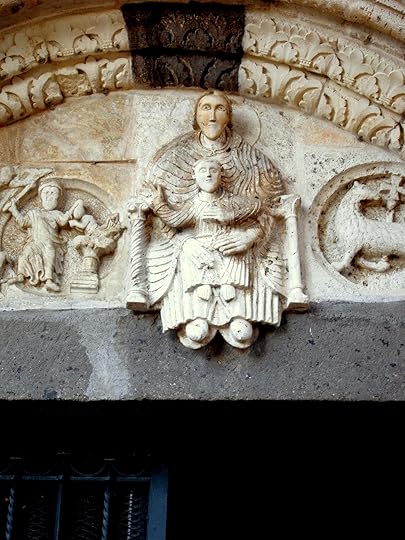 I can never resist stopping to study the façade, especially the extraordinary Madonna and Child hung over the main doorway. The poor things are a perfect example of the decline in craftsmanship during the Dark Ages. The Madonna’s huge hands don’t have much of a hold on the child, who has no baby attributes except for size. Her peculiar face could have been carved by Picasso when he was influenced by African masks – elongated, expressionless, uncaring and unseeing.
I can never resist stopping to study the façade, especially the extraordinary Madonna and Child hung over the main doorway. The poor things are a perfect example of the decline in craftsmanship during the Dark Ages. The Madonna’s huge hands don’t have much of a hold on the child, who has no baby attributes except for size. Her peculiar face could have been carved by Picasso when he was influenced by African masks – elongated, expressionless, uncaring and unseeing.How the ancient Roman sculptors would have laughed at her and the rest of the façade with such a jumble that along with Christian symbols there is an eroded marble panel below St. Peter suggesting a very pagan Green Man, emblematic of the earth’s renewal in spring long before the concept of Easter, along with another one on a side door.

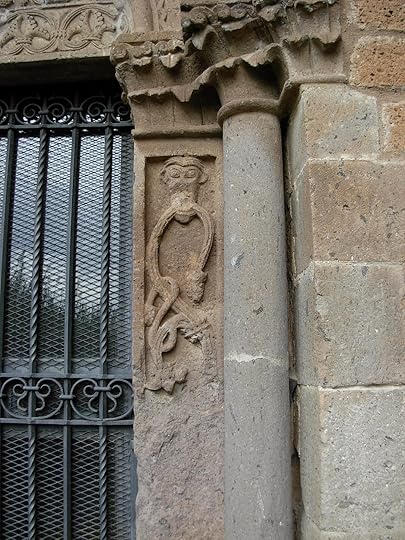
The solemn interior has another selection of marble reminders of the past – from a primitive bishop’s throne and a pulpit assembled from carvings made in many eras, to a beautiful Renaissance-era baptismal font. Taken together, the ensemble shows evidence of labor interrupted and taken up anew. The work continues: a technician, intent on restoring the octagonal font, didn’t look up as we watched his painstaking work to reverse the destructive passage of time and neglect, and scaffolding-lined walls. A few faded frescoes are still visible including an enormous Last Judgment with graphic depictions of tortures so loved by Church fathers for those they consigned to Hell. Too depressing to contemplate on a sunny day when it was nearly lunch time.
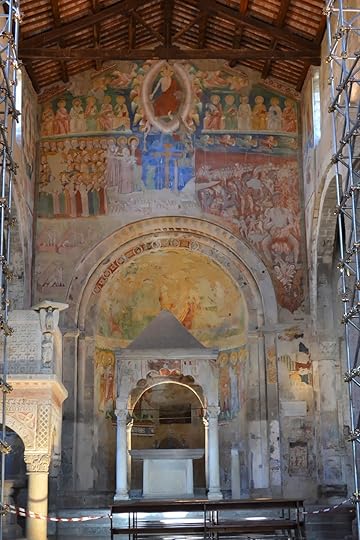
Moving our gaze to the figures on the right side of God who were on their way to Heaven improved our outlook and moved us to return to our time and find a suitable trattoria like they probably did after being released from Purgatory. We found one in the shadow of the town’s walls, Il Peperoncino. Ravioli made by the owner’s granny and roast chicken with rosemary were on the menu along with local wine. We stepped in to rest our feet and brains and please our stomachs. Heavenly indeed.
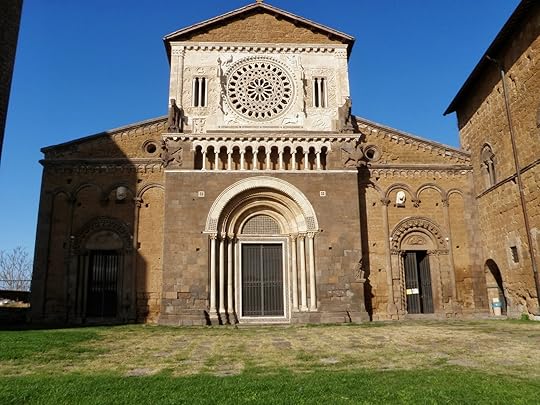 Last and best on the day’s agenda was the Basilica of San Pietro, set on top of the ancient Etruscan acropolis, its foundations resting on the remains of a temple that preceded it by a thousand years. Specialists in the last century believed it was from the 700s but now the consensus has moved the date forward some three hundred years, still not exactly new by my standards. Whatever the date it remains monumental, solitary and enduring as it dominates the surrounding countryside graced with Etruscan tombs, vines and groves.
Last and best on the day’s agenda was the Basilica of San Pietro, set on top of the ancient Etruscan acropolis, its foundations resting on the remains of a temple that preceded it by a thousand years. Specialists in the last century believed it was from the 700s but now the consensus has moved the date forward some three hundred years, still not exactly new by my standards. Whatever the date it remains monumental, solitary and enduring as it dominates the surrounding countryside graced with Etruscan tombs, vines and groves. 
Screaming jackdaws circled fortification towers as we crossed the grassy piazza to enter.

The disused bishop’s palace was the place to pay the small entry fee. A crone in black nodded and smiled as she took our euros. She was so ancient that she might have been resting on a sarcophagus just a few minutes earlier, only coming to life when we showed up. Like most other churches, it was empty of worshipers but in this case full of interest. Franco Zeffirelli found it so evocative that he used it to film a number of scenes in Romeo and Juliet. Sarcophagi line one side wall to complement those resting on the grounds and the city wall.
Stone benches fitted between the squat pillars face each other across the nave. They were used for meetings, no doubt frequently concerned with how to ward off invaders. Faded but still lovely Cosmati floors curl along the center of the nave. A few faint frescoes remaining after disastrous earthquakes lacerated the walls over the centuries – the latest in 1971 – are illuminated by dusty light as the sun gently moves from scene to scene.

Worn steps led us down to the frescoed crypt. The space is supported by a forest of pillars, none matching another in height, shape or style. The layout reminded me of the rows of columns found in the great mosque in Cordoba.

Here too are frescoes, one still brilliantly depicting local patron saints, Secondianus, Marcellianus and Veranius. Whoever they might have been, they are still stylish with red caps rimmed with white and white earmuffs with a red ball hanging below their ears. It was damp and cold in the crypt, then and now.


The exterior displays a conglomerate of styles more harmonious to me than that of Santa Maria Maggiore although it also includes pre-Christian carvings. Along with a typical large rose window and the four Evangelists, a plaque showing either an Atlas holding up the world or an Etruscan priest in a worship posture complements the décor. Surrounding one of the two pillared windows sculpted lush vines spring from the mouth of another Green Man.
Gazing at the deserted church, I found it was easy to imagine the industrious builders scouring the countryside for whatever bits and pieces from a long forgotten pagan past that they could drag to the hilltop to embellish their homage to a Medieval God. Perhaps at some point it will become a center of worship again to continue the endless cycle of time.
Published on March 05, 2014 08:19
January 26, 2014
DEATHLY QUIET IN ROME
THE ENGLISH CEMETERY IN ROME
Are you looking for someplace quiet, someplace restful, someplace away from the noise of Rome? The so-called English Cemetery is an excellent location for contemplation. Not only are the monuments interesting but the landscaping is a delight. Spring brings wisteria, daisies, iris and violets; summer is for lavender, plumbago, verbena and geraniums; fall comes with ripening pomegranates, lemons and oranges. Winter color includes the citrus, camellias and small pink wild cyclamens mixed with the larger and brighter cultivated varieties. Presiding over all are the cypresses, so typical of Italian cemeteries, and umbrella pines. And of course, cats who live in a refuge at the base of the adjoining Pyramid of Cestius.
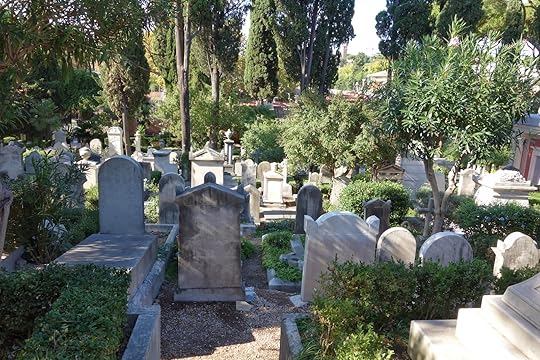
The real name of the resting place of so many is The Non-Catholic Cemetery, and although it does contain the dust of many 18th Century Englishmen who fell while taking their Grand Tour, there are tomb inscriptions in fifteen languages representing about every known non-Catholic religion and the non-religion of Antonio Gramsci, the founder of Italian Communism. The oldest tomb is that of an Oxford graduate who was buried in 1738. Among other interesting bones are those of Goethe’s only son, designer Irene Galatzine who (unfortunately) gave women palazzo pants, and Richard Henry Dana, Jr. who wrote Two Years Before the Mast. Henry James decided that Daisy Miller should be “buried” here.

The 400 tombs are in narrow strip of land abutting the ancient pyramid, the Aurelian Wall, and the busy Via Ostiense – the road to St. Paul’s Outside the Walls and the coast. A metro stop, Piramide, is only a few blocks away from the cemetery’s entrance on Via Caio Cestio (named for the pyramid’s builder). Some are simple flat stones and others have carefully carved sculptures.
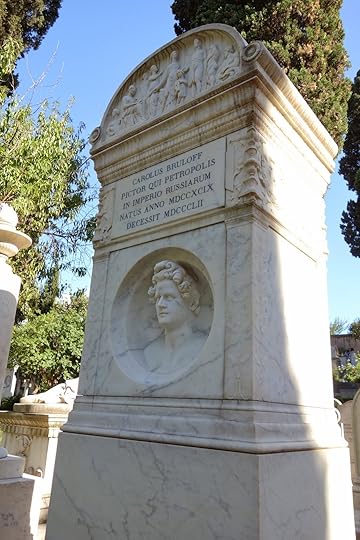
The most famous memorials are to Keats and Shelly.
Keats, died at age 25 of tuberculosis in a villa near the Spanish Steps (now a museum). His last request was to be placed under a tombstone bearing no name or date, only the words, "Here lies One whose Name was writ in Water." But the stone, which under a relief of a lyre with broken strings, also includes the epitaph:
"This Grave / contains all that was Mortal / of a / Young English Poet / Who / on his Death Bed, in the Bitterness of his Heart / at the Malicious Power of his Enemies / Desired / these Words to be / engraven on his Tomb Stone: / Here lies One / Whose Name was writ in Water. 24 February 1821"
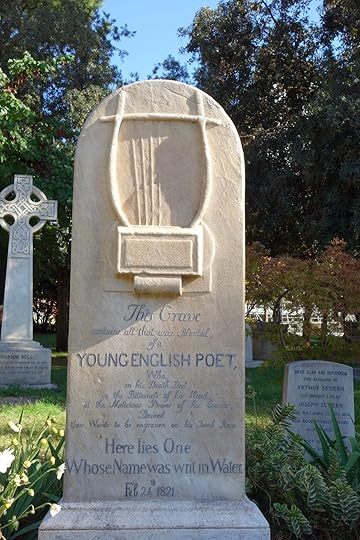
The tomb is in an open grassy area filled with daisies in the spring. It is easy to find because often worshippers drape themselves over the headstone in an attempt to absorb the poet’s gift.
Shelley drowned in 1822 in a mysterious sailing accident near the lovely town of Lerici on the Italian coast south of Genoa. He was cremated on the beach where his body washed ashore, the ashes interred in the crowded main area of the cemetery next to the ancient Aurelian Wall. The inscription reads Cor Cordium ("Heart of Hearts"), and in reference to his death at sea, a few lines of "Ariel's Song" from Shakespeare's The Tempest : "Nothing of him that doth fade / But doth suffer a sea-change / Into something rich and strange."
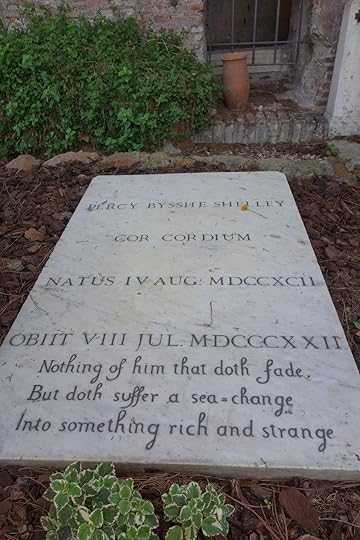
These two tombs are of historical interest but there are many others interesting for their sculpture.
Who can resist that of Devereux Plantagenet Cockburn who was put to rest in 1850? For that matter, who can resist his name? He lounges without a care, languidly holding a book with his faithful dog beside him.

And then there is the Angel of Grief. If you’re into drooping angels, this will be your finest experience. It was sculpted by William Wetmore Story for his wife in 1894. He was the most prominent of the many American sculptors in Rome, where he lived for 40 years.

But if you harbor romantic dreams of being buried in such interesting company, there is a catch: you have to die in Rome to be eligible to rest in such crowded company.

For more info see www.cemeteryrome.it.
All photos by author.
Published on January 26, 2014 12:46
January 1, 2014
CIAO/CHOW TIME - THREE RESTAURANTS IN ROME

It would take several lifetimes to sample all the dining options in Rome. Here are three we found during our last very short visit. So many more to try!
Ditirambo, Piazza della Cancelleria 74. This small, informal restaurant is very close to Campo di Fiori in the heart of tourist Rome. www.ristoranteditirambo.it Recommend reservations. 39.06.687.1626. Moderate prices. Open every day. Monday dinner only.

We ate there at lunch time, and despite its location Italians rather than tourists joined us in savoring creative Italian cooking. Our friend, who is vegetarian, dined on a tasting of their appetizers of eggplant pudding with Moliterno ewe’s cheese and pesto sauce; deep fried zucchini with tomato and smoked buffalo mozzarella and parmesan cheese; and eggplant rolls in Calabrian style (tomatoes and spinach); among other delicacies like Scamorza grilled cheese with truffles and goat cheese with mushrooms.

I toyed with the idea of crispy potatoes with cheese fondue and slivers of black truffles but ended up with home-made tagliolini with artichokes, pork cheek and pecorino Montanaro. Rich!! My husband had something more sensible: the tagliolini with shrimp and asparagus.

We all chose a salad of thinly sliced fennel decorated with pomegranate seeds, as a perfect foil to the rich pasta and appetizers.

Our wine was a Negroamaro, a rich and warming red from Agricole Vallone in Puglia.
Thus fortified for cold weather, we strolled to Campo di Fiori for shopping – there is a large section of spices, some prepackaged for your pasta sauce, and given the holiday season, jars of treats like sauces made with truffles – and photographing vegetables which I can never resist in Italy.

Ristorante Pierluigi, Piazza de Ricci, 144, is located, as they put it, 878 steps from Piazza Navona. (It’s actually close to Via Giula and the Tiber.) Catering to the rich and famous like John Kerry, Frank Bruni, Colin Firth and Lebron James, Pierluigi is high-end and expensive. Dinner time brought out patrons cutting a bella figura, women in designer dresses and serious jewelry and men in well-cut suits or clerical garb. The restaurant, which specializes in fish, has been around since 1938.
Their website is www.pierluigi.it/e and their enjoyable Facebook page is www.facebook.com/pierluigiristorantefilled with photos of the famous and infamous who dine there (Dennis Rodman!). Judging from the crowds filling the rooms, reservations are mandatory. Tel: 39.06.686.8717. Closed Monday. For summer there is an outdoor dining area on the piazza.
Like most Italian fish restaurants we were greeted with their fish display.

The bar near the entrance has inviting space to enjoy their famous cocktails. The main dining room at ground level is plainly decorated. The room in the lower level sharing space with part of the wine cellar looked especially attractive for an intimate meal.

We were with a party of ten and chose a fixed menu: a starter of tartar of eggplant, bufala ricotta-stuffed squash flower, and a carciofo alla giudia(meaning deep-fried artichoke.) Next came a bowl of orecchiette pasta with broccoli sauce and another with three flawless ravioli stuffed with ricotta and spinach. The orecchiette were somewhat heavy, but the ravioli were marvelous and light. The main course was a generous serving of fresh grilled thinly cut tuna with balsamic vinegar served with rughetta and tomatoes. No doubt it was cut from the tuna on display near the restaurant’s entrance.

Fortunately, the dessert was light: paper thin slices of pineapple with an orange sauce. A chardonnay from Pietra Pinto winery in northern Lazio went well with the menu.

Three hours later we rolled out into the cold night, our stomachs full of great food and our hearts full with friendship.
Ristorante Agustarello a Testaccio, Via Giovanni Branca 98, is modest as befits its location – not far from the old slaughterhouse, now the MACRO contemporary art museum (complete with the hooks used for hanging the carcasses and the statue of a man wrestling a bull over the entrance). Moderate prices. No website but reservations advisable by calling 39.06.57.46585. Closed Sunday.

The menu, like many in this area is called cucina povera, cooking for the poor using the quinto quarto,the fifth quarter of the meat – everything that the rich didn’t eat, from the head to the tail. Ironically, these types of offal are not inexpensive.
The restaurant decor is two shades of green, which doesn’t cast a favorable light on the excellent food (and stopped me from taking photos). I have to admit we stayed away from the more exotic offerings like coratella (lamb heart, lung and liver with artichokes), animelle (roasted sweetbreads), or pajata (milk fed lamb intestines). The tail, coda alla vaccinara, was on the menu, but not testarelle (whole roasted lamb’s head). After too much food over the week I happily reverted to plain cavatelli pasta with chicory. Our non-vegetarian guest had roast lamb with potatoes and my husband ordered his favorite: abbacchio allo scottodita,lamb chops so hot you can burn your fingers eating them. We all enjoyed the wonderful coarse Roman bread and my favorite, carciofi alla Romana, Roman-style artichokes meaning those simmered in water with wine, olive oil and herbs. Instead of wine we enjoyed glasses of Menabrea birra, from Italy’s oldest brewery (not really that old: 1846).
This meal brought to a close this stay’s Roman dining experience. We returned to our gorgeous room in our favorite hotel, the San Anselmo, www.hotelsananselmo.com, to pack and set the alarm for an early departure (and to begin a diet).
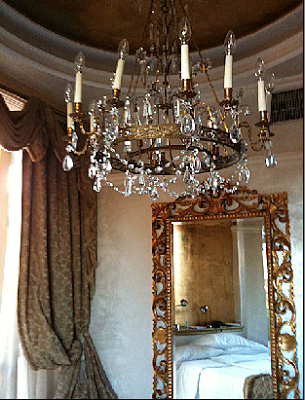
All photos copyright by author except 3 interior views of Pierluigi, which are from their site.
Published on January 01, 2014 14:22

